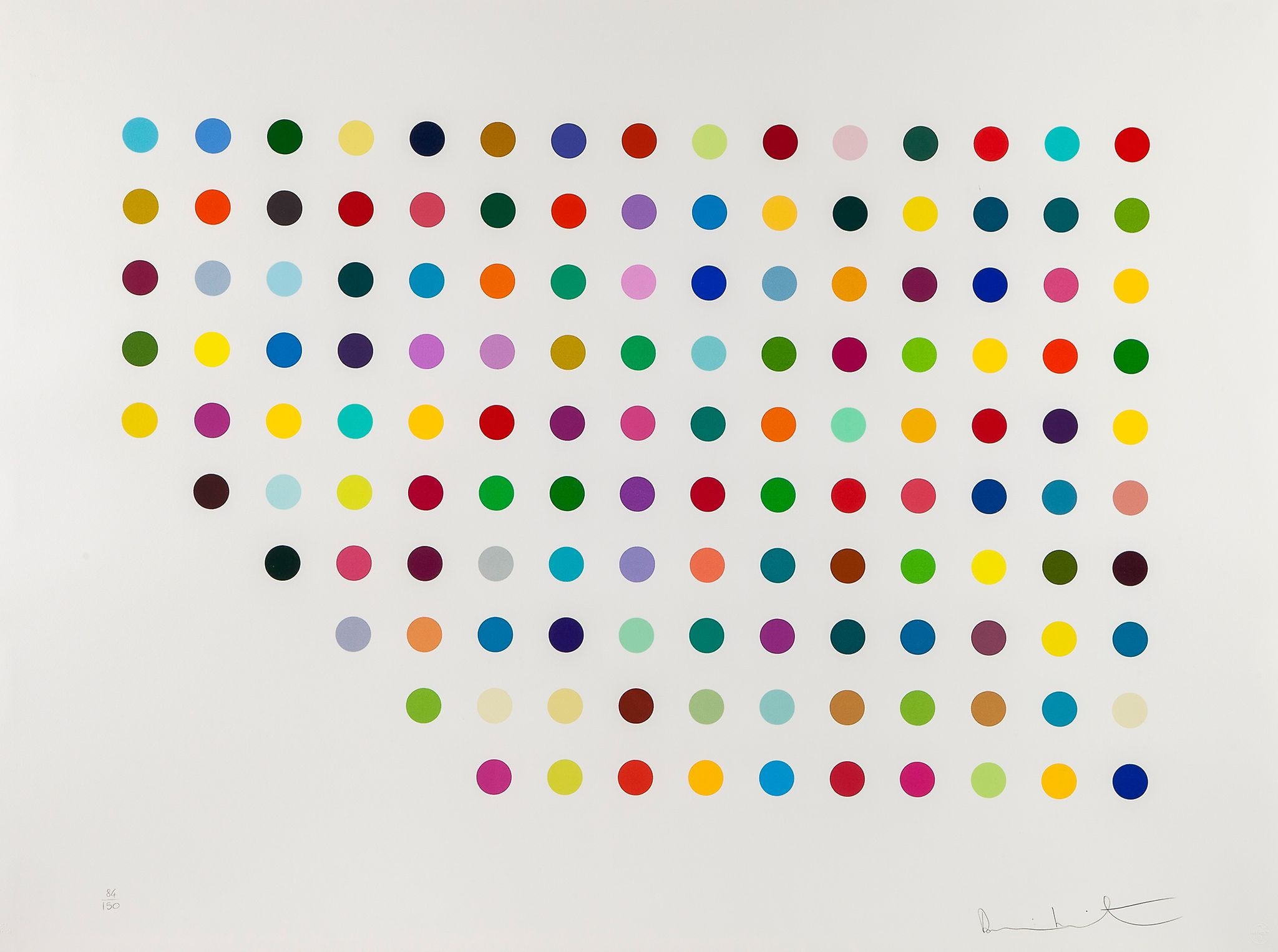Universal, timeless, and immediately recognizable, when you think of Damien Hirst, chances are his Spot prints come to mind. These works have become iconic in British culture, characterized by their recurring, unblinking, confrontational, and often sardonic dialogue with death, mortality, and the human condition. Hirst's Spot paintings and prints have achieved universal recognition, to the point where spots en-masse are synonymous with the artist himself. Their application and the underlying theory have helped redefine international expectations of British art and contemporary art in general. The iconic nature of such work is partly because Hirst, almost more than any other artist of the ’90s, became familiar via the media, especially after his Turner Prize win in 1995. This media presence is something Hirst relishes and uses to his advantage.
The Spot works are created with geometrical precision and titled after pharmaceutical ingredients. Hirst has remarked on the close relationship between science and creative practice, saying, “They’re an idea about the ultimate variety of paintings, or what you’d imagine a sculpture would look like under a microscope.” The random and infinite color combinations within the Spot series are integral to the works. Hirst explains, “Mathematically, with the Spots paintings, I probably discovered the most fundamentally important thing in any kind of art, which is the harmony of where color can exist on its own, interacting with other colors in a perfect format.” Beyond their aesthetic qualities, the names of each piece hold crucial clues to their possible meanings. The names, derived from a book of medical definitions Hirst frequently consulted, indicate each piece is a set of pills, a code, or genetic structure containing the by-products of the stated name. These names often include descriptions that outweigh any perceived benefits with hideous or dangerous side effects (toxicity, addiction, sickness), making the Spot series a brutal socio-economic critique.

Methylamine 13c is an etching showing a grid of colored dots organized into five rows of four, evenly distributed across the print. This work is a print edition of one of Hirst’s famous Spot paintings. No colored dot is the same in this rectangular composition, and the systematic grid is set against a black backdrop. Methylamine is a chemical compound used in the production of pharmaceuticals and pesticides. It is known for its application in the synthesis of methamphetamine, aligning with Hirst’s exploration the darker aspects of chemical compounds.

Ethidium Bromide Aqueous Solution is a signed etching by Hirst, showing many spots arranged methodically in rows, identical in size and shape. Each spot is a different color, and every print in the series represents a unique set of color combinations, marking Hirst’s fascination with exploring color and form. Ethidium bromide is commonly used as a nucleic acid stain in molecular biology for techniques such as gel electrophoresis. It is known to be a mutagen and toxic, reinforcing Hirst's critique of the potentially harmful effects of chemicals.

Diacetoxyscirpenol is an etching that shows a composition that is a variation on Hirst’s famous Spot paintings. The print is oriented horizontally and displays several rows of grey, blue, and cream spots, each a perfect circle. Diacetoxyscirpenol is a type of mycotoxin produced by fungi, known for its toxicity and potential to cause severe health issues, including immunosuppression and toxicity to multiple organ systems.

Meprobamate is a screen print showing a number of brightly colored spots in a grid-like formation, with the left-hand corner of the grid removed. The Spot paintings are crucial to understanding Hirst’s quasi-scientific rationality that underpins much of his practice. Meprobamate is a medication used to treat anxiety disorders and is known for its potential for addiction and abuse, inviting us to join with Hirst's exploration of the paradoxical nature of pharmaceuticals that both heal and harm.
Damien Hirst’s Spot paintings are more than just visually captivating artworks; they are complex, multi-layered critiques of contemporary society, exploring themes of mortality, the human condition, and the socio-economic structures that influence our lives. Through his precise use of color and form, Hirst has created a body of work that continues to challenge and redefine the boundaries of contemporary art.
Explore Damien Hirst prints for sale and contact info@guyhepner.com for latest availabilities. Looking to sell? Speak to our team to sell Damien Hirst prints.

